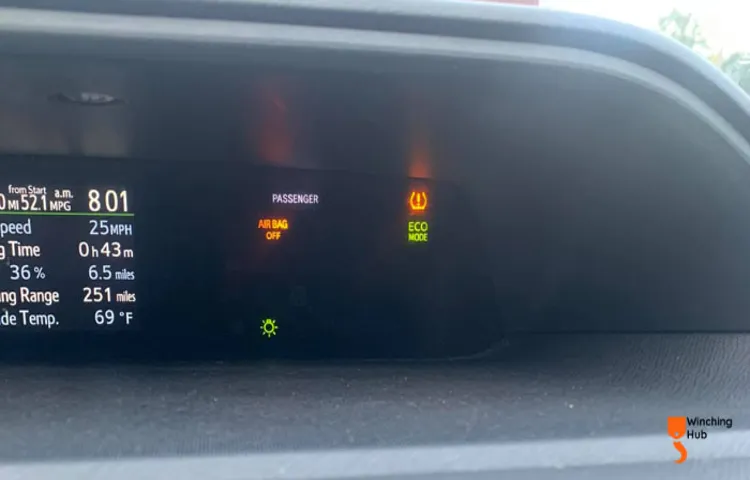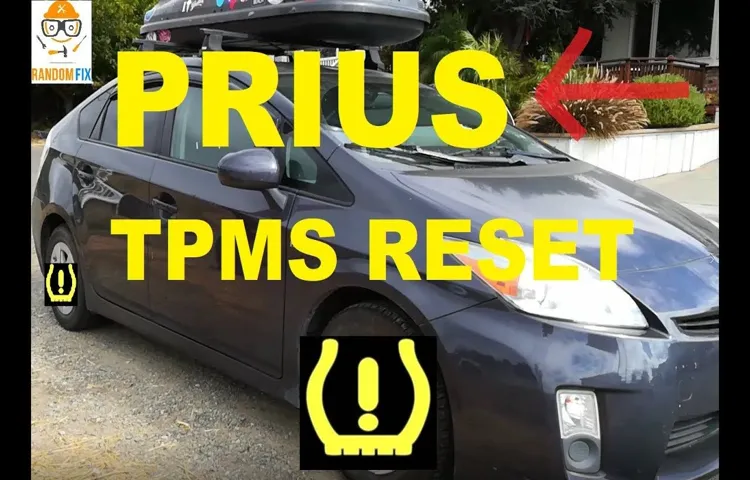If you own a Prius, then it’s essential to know your tire pressure. Proper tire pressure not only increases the vehicle’s life span, but it also ensures safety while driving. Many people tend to overlook this crucial factor and only check the tire pressure when it’s too late.
However, knowing Prius tire pressure isn’t a complex task; it’s simple and quick. This blog post will explain everything you need to know about the Prius tire pressure, including how to check and maintain it. So, buckle up and let’s dive in!
Importance of Maintaining Proper Tire Pressure
As a Prius owner, it’s important to know what the proper tire pressure should be. The recommended tire pressure for a Prius is typically 32 PSI (pounds per square inch). However, it’s important to check your vehicle’s owner’s manual for the specific tire pressure for your model.
Proper tire pressure not only helps with fuel efficiency, but it also improves handling and safety on the road. Underinflated tires can lead to poor fuel economy and can even cause wear and tear on the tires, leading to a shorter lifespan. On the other hand, overinflated tires can make for a bumpy ride and can also cause uneven wear on the tires.
It’s important to check your tire pressure regularly (at least once a month) and adjust accordingly. Remember, your tires are the only point of contact between your vehicle and the road, so maintaining proper tire pressure is crucial for a smooth and safe ride.
Increases fuel efficiency
Maintaining proper tire pressure is crucial when it comes to increasing fuel efficiency. It may seem like a minor detail, but it can have a significant impact on your vehicle’s overall performance. When tires are underinflated, the vehicle’s engine has to work harder, wearing down its components and increasing fuel consumption.
Studies have shown that keeping your tires inflated to the recommended pressure can improve fuel efficiency by up to 3%. That may not sound like much, but it can add up to significant savings over time. Plus, it’s safer to drive on properly inflated tires as they provide better control and handling, reducing the risk of accidents.
So, the next time you head out on the road, take a few minutes to check your tire pressure and make sure it’s at the manufacturer’s recommended level to maximize fuel efficiency and keep yourself safe.

Improves handling and stability
Maintaining proper tire pressure is crucial for improving handling and stability on the road. Overinflated or underinflated tires can lead to a variety of issues such as decreased fuel efficiency, reduced tire life, and difficulty staying in control of the vehicle. In contrast, tires that are inflated at the correct pressure promotes even tread wear and maximizes the contact area between the tire and road, leading to optimal performance.
The proper inflation level can typically be found in the owner’s manual or on the tire itself. Taking the time to regularly check and adjust tire pressure can go a long way in ensuring your safety and the longevity of your tires. So, make it a habit to check your tire pressure at least once a month and before long trips.
Your vehicle and your wallet will thank you!
Extends tire life
Maintaining proper tire pressure is crucial for increasing the lifespan of your tires. When tires are underinflated, they are more susceptible to wear and tear due to increased friction between the tire and the road. Not only does this impact the longevity of your tires, but it can also lead to decreased fuel efficiency, as your car’s engine must work harder to keep the vehicle moving.
On the other hand, overinflated tires can cause excessive wear on the tire’s center, reducing its contact with the road and decreasing stability. By keeping your tires properly inflated, you can extend their lifespan and avoid unnecessary wear and tear. It’s important to regularly check your tire pressure and adjust as necessary to ensure your vehicle is running efficiently and safely.
Remember, maintaining proper tire pressure isn’t just about saving money, it’s about ensuring your safety on the road.
Recommended Tire Pressure for Prius
“What should Prius tire pressure be” is a common question among Prius owners. The recommended tire pressure for a Prius can be found in the owner’s manual, and it typically ranges from 32-35 PSI. However, it is important to note that the recommended tire pressure may vary depending on the specific model and year of the Prius.
Maintaining the appropriate tire pressure is crucial for several reasons. Firstly, it can help improve fuel efficiency and prolong the life of the tires. Additionally, it can also affect the handling and safety of the vehicle.
It is recommended to check tire pressure at least once a month and to adjust it accordingly. Overinflated or underinflated tires can lead to uneven wear, decreased traction, and potentially dangerous driving conditions. So, make sure to keep your Prius tires properly inflated to ensure a smooth and safe driving experience.
Based on model and year
As a Prius owner, it’s important to ensure that your vehicle’s tire pressure is regularly checked and maintained at the recommended level. The recommended tire pressure for Prius models can vary based on the year of the vehicle and the type of tires you have. For example, the recommended tire pressure for a 2018 Prius with standard tires is 35 psi, while a 2012 Prius with the same type of tires has a recommended pressure of 32 psi.
Always consult your owner’s manual or a qualified mechanic to ensure you’re using the correct tire pressure for your vehicle. Maintaining the correct tire pressure not only helps to improve fuel efficiency, but it also ensures better traction and handling on the road. So, take the time to check your tire pressure regularly, and enjoy the benefits of a smoother, more efficient ride.
List of recommended tire pressures
If you are a proud owner of a Prius, then it is essential to know the recommended tire pressure. The ideal tire pressure for a Prius ranges between 35-42 pounds per square inch (PSI). However, the recommended tire pressure may differ based on the specific model of your Prius, so it is always best to check your car’s user manual or the sticker located on the driver’s side door jamb.
It is vital to keep your tires inflated to their recommended PSI level, as this not only ensures your safety on the road but also saves fuel and helps your tires last longer. Overinflating or underinflating your tires can cause issues with handling, braking, and even cause tire blowouts. By keeping your Prius’s tires at their recommended pressure, you can enjoy a smoother driving experience while also promoting better fuel efficiency and prolonging the lifespan of your tires.
How to Check and Adjust Prius Tire Pressure
As a Prius owner, it’s crucial to keep your tire pressure at the correct level to ensure optimal performance and safety. The recommended tire pressure for Prius models varies depending on the specific make and model, but it usually ranges between 35 to 40 psi (pounds per square inch). You can typically find the recommended tire pressure on the driver-side door jamb or in the owner’s manual.
To check your tire pressure, you’ll need a tire pressure gauge, which can be found at any auto parts store or gas station. First, remove the valve cap on the tire, and then place the gauge onto the valve stem, firmly pressing it down until the hissing sound stops. The readout on the gauge should show you the current tire pressure.
If the pressure is above or below the recommended level, adjust it accordingly by adding or releasing air until it’s correct. Remember to check your tire pressure every month, especially during seasonal changes, to ensure the safety and longevity of your vehicle.
Tools needed
As a Prius driver, it’s important to always keep your car’s tire pressure in check. This not only enhances your car’s performance but also improves gas mileage and keeps you safe on the road. To check and adjust tire pressure, you’ll need a few tools, including a tire pressure gauge and an air pump.
These tools are inexpensive and readily available at any auto store. Once you have them, start by checking the recommended tire pressure for your Prius, which can be found on the driver’s side door or in the owner’s manual. Using the tire pressure gauge, measure the air pressure in each tire and compare it to the recommended psi.
If the pressure is too high or low, use the air pump to inflate or deflate the tire accordingly. Checking and adjusting tire pressure should be done at least once a month, and more often during changes in weather or before long trips. By doing so, you’ll ensure a smooth ride, better gas mileage, and safer travels.
Step-by-step instructions
Checking and adjusting tire pressure on a Prius is a simple task that can help you maintain optimal fuel efficiency and keep your car running smoothly. Here’s a step-by-step guide to help you get started. First, check your owner’s manual to find the recommended tire pressure for your Prius.
Once you’ve determined the correct pressure, use a tire pressure gauge to check the pressure in each tire. If the pressure is too high or too low, adjust it accordingly using an air compressor or a tire inflator. Make sure to check the pressure again after inflating or deflating the tires.
Finally, don’t forget to reset the tire pressure monitoring system to ensure accurate readings. Regularly checking and adjusting your Prius’ tire pressure will ensure a safe and efficient driving experience, and can help extend the life of your tires. So, take a few minutes to check your tire pressure today and enjoy the benefits of a well-maintained Prius!
Conclusion
In conclusion, determining the optimal tire pressure for your Prius is like finding the perfect balance in life – too little pressure and you’ll feel sluggish and inefficient, too much and you’ll risk losing control. So, just like in life, it’s best to strive for balance and aim for the recommended tire pressure range provided by Toyota. Your Prius (and your safety) will thank you for it!”
FAQs
Why is it important to maintain the correct tire pressure in a Prius?
Maintaining the correct tire pressure in a Prius ensures optimal fuel efficiency and handling, and also prevents premature tire wear.
How do I check the tire pressure in my Prius?
To check the tire pressure in your Prius, locate the tire pressure monitoring system in the instrument cluster or consult your owner’s manual for instructions.
What should be the recommended tire pressure for my Prius?
The recommended tire pressure for a Prius may vary depending on the specific model and tire size, but it is typically around 32-35 psi.
What happens if I over-inflate my Prius tires?
Over-inflating your Prius tires can lead to poor handling, premature tire wear, and a rough ride.
What happens if I under-inflate my Prius tires?
Under-inflating your Prius tires can lead to decreased fuel efficiency, poor handling, and increased risk of a blowout or other tire-related issues.
How often should I check my Prius tire pressure?
It is recommended to check your Prius tire pressure at least once a month, or before a long trip.
Can I inflate my Prius tires with a regular air compressor?
Yes, you can inflate your Prius tires with a regular air compressor, but make sure to use a pressure gauge to ensure you reach the correct pressure level.

